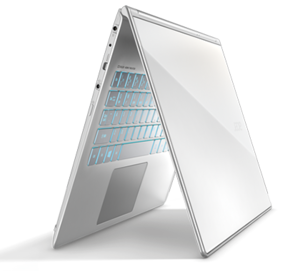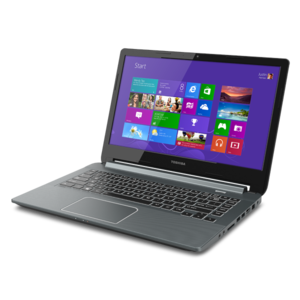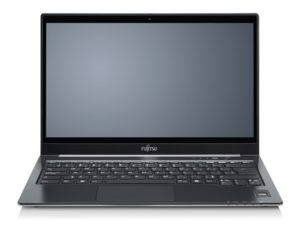
In the market for a new laptop? Think about the features you’re likely to prize the most: a slim design, a travel-friendly weight, lightning-fast performance, and outstanding battery life.
You’ve just described an Ultrabook. Although the term gets thrown around almost generically in describing modern-day portable PCs, Ultrabook represents Intel’s vision for what a laptop should be: thin, light, powerful, and able to last a good long time between visits to a power outlet.
Also, versatile. Models like the Acer Aspire S7-391 and Toshiba U925t sport touchscreen displays, giving you finger-powered access to some of Windows 8’s best features and apps. And the
Asus Taichi 21, Lenovo IdeaPad Yoga 13, and Sony Vaio Duo 11 are among those offering convertible designs, meaning they can pull double duty as Windows-powered tablets.
Regardless of what size, form factor, or feature set you choose, you’ll enjoy probably the fastest boot times you’ve ever seen from a laptop. Thanks to Intel’s Rapid Start technology, which relies on flash memory embedded on the laptop's motherboard, and Windows 8, which is optimized for faster booting, many Ultrabook systems go from dark to desktop in a matter of seconds.
One feature you won’t find inside most Ultrabook systems is an optical drive, and with good reason: When was the last time you burned a CD or DVD or installed a piece of software from one? By dispensing with that old-fangled and largely unnecessary technology, manufacturers can make their Ultrabook models as svelte and sexy as runway models.
Although dozens of laptops meet the Ultrabook criteria and share those general specifications, there’s still a lot of variety between them, and a lot of decisions to be made when choosing one. With that in mind, let’s take a look at what you’ll want to consider when buying an Ultrabook.
Screen Size and Resolution
Decision number one: screen size. Most Ultrabook systems incorporate 13.3-inch displays, usually running at 1,366 x 768 pixels—a good resolution for an LCD of that size, though some users will no doubt covet a higher pixel count so they can squeeze more windows, text, spreadsheet cells, and other data onto the screen. The trade-off: everything looks smaller, in which case a physically larger LCD might be preferable.
Indeed, although 13.3 inches represents something of a sweet spot, keeping the laptop thin and light while still providing a comfortable work area, some models swing larger—or smaller. The Dell XPS 12 Convertible and Sony Vaio Duo 11, for example, promise a bit more portability with their 12- and 11.6-inch screens, respectively. The HP Envy 4-1130us, HP Spectre 14 and Toshiba Satellite U945-S4140 raise the stakes to 14 inches, while the Dell Inspiron 15z and Vizio CT15-A4 are among the models with 15.6-inch LCDs.
Needless to say, screen size plays a big part in the weight and overall size of the Ultrabook. The aforementioned Sony Vaio Duo 11 measures 12.6 x 7.8 x 0.7 inches and weighs around 2.9 pounds, while the Vizio CT15-A4 measures 14.9 x 9.9 x 0.7 inches and tips the scales at 3.9 pounds. But there are exceptions to the rule: the 14-inch Toshiba Satellite, for instance, weighs a bit more than the 15.6-inch Vizio, despite having a smaller screen. And the Dell Inspiron 15z keeps to a 1,366 x 768 display resolution, despite having a larger screen. (Ironically, the comparatively tiny Sony Vaio Duo 11 delivers a full 1,920 x 1,080 pixels, proof positive that size doesn’t always dictate capabilities.)
Unless you specifically need an extra-large or extra-small screen, you’ll find the widest selection of models if you limit your shopping to 13.3- and 14-inch Ultrabook systems. And with that decision out of the way, you can focus on the next big one: to touch or not to touch.
Screen Type
Now that we’re all accustomed to tapping, swiping, and pinching our smartphones and tablets, it stands to reason we’d like to interact likewise with our computers. To that end, Microsoft developed Windows 8 with touchscreens in mind, and computer manufacturers followed suit in developing Ultrabook systems.
Put simply, some models have touchscreens, some don’t. If you’re looking at a convertible, it’s a given: they double as tablets, so a touchscreen is essential. You can’t buy a convertible without one. But for the more laptop-like Ultrabook systems, you’ll have to decide if that’s a feature you want.
The advantages are these: Windows 8 responds better to fingertips than it does to a mouse, especially if you’re working within Microsoft’s new tile-driven “Metro” interface. And speaking of which, that interface provides access to thousands of tablet-style apps, most of which were designed (or at least optimized) for taps and swipes, not mouse-clicks.
For example, an app called Fresh Paint lets you create works of art by drawing right on the screen, using either your finger or a stylus as your brush. And SkyMap’s interactive planetarium takes you to the stars, allowing you to zoom through the galaxy by pinching your fingers. To put all this another way, touchscreens give you a more practical way to navigate Windows, but they’re also just kind of fun.
On the flipside, they weigh a bit more than non-touchscreen LCDs, so plan on a slightly heavier Ultrabook. They also cost a bit more, so plan on a slightly pricier one as well. But those are the only real downsides, so if you can handle a few extra ounces and dollars, a touchscreen is definitely worth having.
Laptop Versus Convertible
Having made the decision to get touchy-feely with your Ultrabook, now consider whether a convertible model might be in order. Leveraging a hinged, rotating, or sliding screen,convertibles can transform themselves from traditional laptop to full-fledged tablet and back again.
The Lenovo Thinkpad Twist S230u, for example, looks like an ordinary laptop, right up until you give its 12.5-inch touchscreen a 180-degree spin, then fold it down over the keyboard. Presto: it’s a tablet. Similarly, the Dell XPS 12 employs a screen that can swivel on a horizontal axis inside its own frame. That allows for not only a fold-down tablet arrangement, but also a rear-facing screen that could prove useful for presentations.
The Asus Taichi 21 takes this idea a step further with dual screens, both front- and rear-facing, so users on either side of the system can see the same image. If you’re on vacation with your family and everyone wants to watch a movie, you needn’t try to squeeze everyone around a single screen. Some can sit in front, some can sit in back.
Finally, Ultrabook systems like the Lenovo IdeaPad Yoga 13 have screens that can pivot a full 360 degrees, giving you not only laptop and tablet modes, but also a standing “tent” mode in between that’s nifty for up-close movie viewing and easier access to touchscreen features. However, in tablet mode this leaves the keyboard exposed underneath, which can make for awkward handling. If you plan to use this mode a lot, look for a screen that covers the keyboard, not one that merely tucks around behind it.
Processor
Choosing a processor has always been a tricky proposition, if only because it can be difficult to translate various specifications into real-world performance. Thankfully, by definition an Ultrabook has at least an Intel Core i5 processor, which translates to speedy performance for mainstream computing tasks like word processing, Web browsing, movie watching, and email.
In other words, the baseline Ultrabook processor should be more than sufficient for most of your work and play. However, if your work includes mammoth spreadsheets, CAD drawings, video files, and the like, and your play includes graphics-intensive games, look for a model with an Intel Core i7 processor. What’s more, an Ultrabook with discrete (as opposed to integrated) graphics hardware will definitely help applications and games that rely heavily on video and/or 3D graphics.
For example, the Samsung Series 5 NP550P5C comes with an Intel Core i7-3610QM processor and an Nvidia GeForce GT 630M graphics chip, a one-two power punch that can easily handle high-end software and games.
Storage
Storage is one key area that separates the Ultrabook from conventional notebooks. By taking advantage of solid-state drives (SSDs), which have no moving parts, Ultrabook systems run faster, quieter, cooler, and longer than systems with traditional, mechanical hard drives. SSDs are also more reliable, at least when it comes to surviving knocks and drops.
However, because SSDs haven’t quite caught up to their platter-spinning counterparts in terms of capacity, most Ultrabook systems come with either a 128GB or 256GB drive. If you need more storage, look for a model with a hybrid drive, like the Asus VivoBook S400CA or Lenovo U410. These pair a smaller amount of flash storage with a larger traditional hard drive, thus giving you the benefits of fast bootup while still affording lots of storage space. The Asus and Lenovo each incorporate a 24GB SSD for startup chores, plus a 500GB and 1TB hard drive, respectively, for programs and data.
Ironically, this kind of hybrid setup may actually save you a few dollars, as large-capacity SSDs can get expensive. However, you won’t get all the speed and battery benefits of a straight-SSD configuration. So stick with that if you can live with less storage (this is the cloud age, after all) and have the room in your budget.
Keyboard and Touchpad
Even if you’re eyeballing a touchscreen-equipped convertible, you’ll probably use the system as a traditional laptop for at least some tasks. That means you’ll want a comfortable keyboard and responsive touchpad—traits that can be hard to gauge just by looking at specs and photos.
Therefore, it’s worth a trip to your local computer or electronics store to get some hands-on time with different Ultrabook models. See how the keyboard feels beneath your fingers. Try some multi-touch gestures (like two-finger scrolling) on the touchpad and make sure there’s no lag. Laptop buyers are frequently distracted by marquee features like the screen and processor, but the quality and comfort of the keyboard and touchpad can really affect your overall enjoyment of the system. If at all possible, try before you buy.
Battery Life
Ultrabook systems are known for sipping power, not guzzling it like conventional laptops. You’ll often see manufacturers touting battery life of eight, nine, or even 10 hours—long enough for a coast-to-coast flight with a layover in Denver.
For example, the Asus Zenbook Prime UX31a has a rated battery life of seven hours, while Lenovo’s IdeaPad Yoga 13 can run for up to eight. But the Fujitsu Lifebook U772 tops them all with a rated runtime of 10 hours. That’s pretty amazing when you consider that a lot of laptops peter out after just 3-4 hours—sometimes even less than that. If you need to work all day without stopping to find an AC outlet, an Ultrabook is without question your best bet.
Bonus Features
Once you’ve figured out the important stuff, like screen size and style, you can focus your attention on the little amenities that some Ultrabook systems offer to enhance the user experience. For example, the Dell Inspiron 15z and HP Envy 4-1130us are among those models to include a backlit keyboard, which is great for working in dimly lit offices, airplanes, and the like. And speaking of keyboards, the Inspiron’s is also spill-resistant, a nice perk if you’re the clumsy type.
Some systems, including the Toshiba Portege Z935-P300, incorporate Intel’s WiDi technology, which allow them to connect wirelessly to compatible external displays (like TVs and projectors)—a decidedly handy feature if you use your laptop for presentations.
Another handy extra: dual-band Wi-Fi, which can be found on the Vizio CT15-A1, among a handful other models. That lets it work not only with the 2.4GHz hotspots found in most areas, but also with any 5GHz hotspots you might encounter. While you’re at it, you might also want to check for an Ethernet port, a feature some Ultrabook systems omit in an effort to stay skinny. If you’re in a hotel or office that lacks Wi-Fi but offers Ethernet connectivity, you might bemoan the missing port.
Making Your Choice
Shopping for an Ultrabook may seem a bit intimidating, if only because you have so many choices, but it’s actually pretty easy to pick one. They’re all speedy, slim, and comparatively lightweight, and definitely faster at booting Windows than the laptop you’re using now. So the only really big decision is whether you want a touchscreen and/or convertible design. With that choice made, everything else should fall nicely into place.















0 comments:
Post a Comment